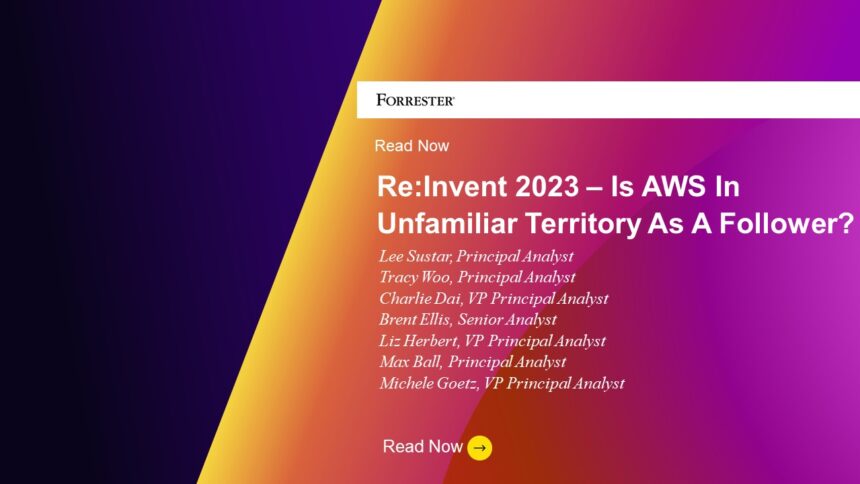AWS re:Invent 2023 had many of the usual trappings: lots of Las Vegas glitz, energy from loyal customers, a vast array of partners, more than 200 service announcements, and the combined energy of 55,000 attendees. But through all of the noise and hubbub of a conference that spans over several square miles and multiple casino resorts was constant discussion around generative AI, as attendees waited for a resounding AWS response to Microsoft’s moves earlier this year (its splashy partnership with OpenAI and the subsequent release of Copilot) and Google Cloud’s revamped AI offerings. The expectation walking into the conference was that AWS would — as it always does — firmly reestablish itself as the cloud provider that leads in all categories — even generative AI.
Not this time.
The AI Announcements Were Underwhelming
In any other year, this would have been a typical exhibition of innovation that has always propelled AWS to market-share leadership in public cloud. But this is the year of generative AI. Where we expected a major generative AI announcement from AWS. And where there wasn’t any. There was no decisive response to Microsoft, nor any new service announcements that would preempt rivals on the generative AI front. This year’s re:Invent did not deliver a polished, enterprise-ready generative AI platform that the average non-technically-savvy enterprise can readily adopt. Many new AI services were announced in preview only. And the response to the Microsoft-OpenAI relationship was an AWS-Anthropic alliance doesn’t have the same capabilities or gravitas. AWS instead focused on orienting its vast array of customers on how to use AWS infrastructure. Tools that can deliver the AI capabilities bosses are demanding while reassuring customers that if the services aren’t available yet, they’ll be coming soon. While AWS’ competitors have had a head start in bringing capabilities to market, especially top competitor Microsoft Azure. No one should be underestimating AWS — least of all its main competitors. But for re:Invent, where we expect to be awed by innovation, it was an underwhelming set of AI announcements and messaging.
A Lackluster Response To Tough Generative AI Competition
AWS did join the generative AI battle with Q, a Copilot competitor based on AWS’s Bedrock AI infrastructure. Q offers large language model capabilities with plugins for specific functionality, such as Q Code Transformation. Q complements and integrates with established services such as CodeWhisperer and QuickSight, as well as Bedrock itself. Some tools were even quite impressive, such as the Q IDE extension for AWS Application Composer, CodeCatalyst, OpenSearch Serverless, and SageMaker Clarify. Q’s combination with AWS Glue provides a natural language interface for data integration, eliminating much of the time (and headaches) that such efforts typically entail. The AWS Titan family of foundation models for generative AI provides a managed API for pretrained models, a key focus of AI competition
.On another AI front, AWS flexed its infrastructure strength by announcing Trainium2, positioned as the anti-NVIDIA GPU (despite announcement of a deeper relationship with NVIDIA via CEO Jensen Huang moments earlier), and S3 Express One Zone (an amazing feat in itself as, up until now, S3 only spanned across multiple regions). AWS also claimed that its Bedrock offering (a managed AI/ML platform pushed out at breakneck speed to counter Microsoft’s OpenAI-based services) has 10,000 customers — a number that suggests that the customer list has few filters regarding “usage” or scale. A sit-down mainstage chat between AWS CEO Adam Selipsky and Anthropic CEO Dario Amodei conveyed AWS’s AI bona fides but no breakthroughs.
While announcements were underwhelming, don’t count AWS out of the AI race. Certainly, there is the basis for AWS to counter the Azure challenge (not to mention Google Cloud’s genAI efforts and Oracle’s SuperCluster offering). Q will doubtless get more capabilities in the near future, and Bedrock will gain momentum among customers with a data gravity in AWS. But in generative AI — central to today’s value proposition for public cloud — AWS is just not there yet.
In Other Areas, Here’s Our Take
AI/ML. AWS announced customization capabilities for Amazon Bedrock, including fine-tuning, Retrieval Augmented Generation (RAG) with knowledge bases, and continued pre-training for Amazon Titan Text Lite and Express. These features are essential for enterprises to adopt foundation models, yet AWS did not clarify how to unite the management of AI models across foundation models (powered by Bedrock) and traditional ones (powered by SageMaker). AWS should also provide a broader view on how to support broader integration choices, such as vector databases other than OpenSearch and containerized application development beyond Lambda/FaaS. In the conversation with AWS, Anthropic’s Amodei stated that it will launch system message support for prompt engineering. This is critical for enterprises to fine-tune foundation models and truly unleash the power of Q for internal developers and ops team. Nevertheless, AWS didn’t provide messaging on the vision and roadmap of prompt engineering support across major areas, such as few-shot learning, output priming, and chain of thought, beyond system message support by partners.
Data/analytics. The announcement of AI recommendations for Amazon DataZone is to use generative AI to create business descriptions for the data in the data catalog. This is useful for data catalogs that don’t have defined business context in place, which can be a real challenge for some legacy systems that lack data governance. And since modern enterprise architecture and data management practices normally start with the business capabilities, the DataZone announcement also helps AWS fill the functionality gap in data governance. Second, the rapid adoption of generative AI is introducing new artifacts across the entire model lifecycle, such as prompts, prompt templates, pretrained data corpuses, fine-tuned data sets, RAG knowledge repositories, and indexes generated. AWS needs product improvements to manage these artifacts together with traditional ones. In addition, as the foundation models will be shared across data zones, it’s necessary to have the governance across data zones beyond the in-zone governance. It might be necessary to orchestrate the function calls triggered by the RAG across zones, as well.
Infrastructure. AWS unveiled new Graviton4 ARM chips, extending AWS’s investment in custom silicon as a differentiating element of its cloud platform. The company highlighted cost savings that companies have accrued, which factor heavily into sustainability efforts. Intel silicon also got a boost with a new, high-memory U7i instance type for memory-intensive workloads such as SAP HANA. There were several incremental improvements to core storage services, but two announcements that stood out were the S3 Express One Zone offering and the improvements to FSx for NetApp. The new S3 offering addresses increasing demand for high-performance, low-latency object storage to address analytics, AI, and cloud-native applications. NetApp improvements include scaled-out NetApp clustering to six paired storage controllers for 9x performance improvement aimed at large and/or latency-sensitive workloads. Another improvement for storage: NetApp FlexGroup management in the AWS Console, a boon to operators. Resilience got a boost with zonal autoshift, a new feature that will move application traffic via Route 53 when AWS service issues are detected and shift it back when service health is restored. Application Load Balancer now offloads client authentication verification to ensure secure connections with back-end servers, reducing the chance for gaps in security.
Enterprise apps. The AWS story around business applications — mostly through partnerships — continues to strengthen. The Workday marketplace and partnership announcement earlier this year and, now, Salesforce and ServiceNow will be helpful for organizations looking for rationalization and cost reduction through electronic data processing and sourcing efficiencies. AWS customers can take advantage of real sourcing and cost advantages and look for opportunities for greater synergies between their use of AWS infrastructure and leading enterprise app providers.
Contact center. AWS continues to invest in the Connect offering for contact centers. A couple of new feature highlights include very interesting things around agent assist, creating an agent assistant built on top of Q, and extending the Flow Builder development tool to develop agent assist applications. AWS also made some announcements around new extract, transform, and load capabilities that hold exciting promises for customer service where data is critical and typically spread across several systems. Fast and easy synchronization of this information is valuable to the contact center, and much of this information is even more interesting to marketing, product, customer experience, and many other teams.
Of course, this is only a fraction of the announcements at re:Invent. For more perspective from us (Lee Sustar, Tracy Woo, Charlie Dai, Brent Ellis, Liz Herbert, Max Ball, and Michele Goetz) or any other Forrester analyst, book an inquiry or guidance session at inquiry@forrester.com.







